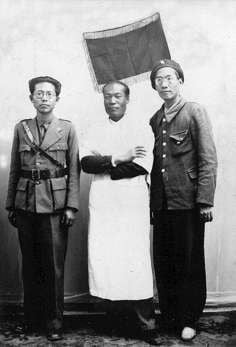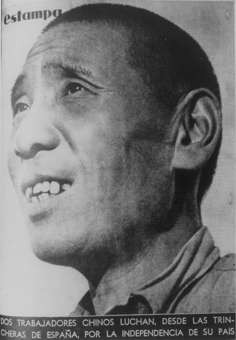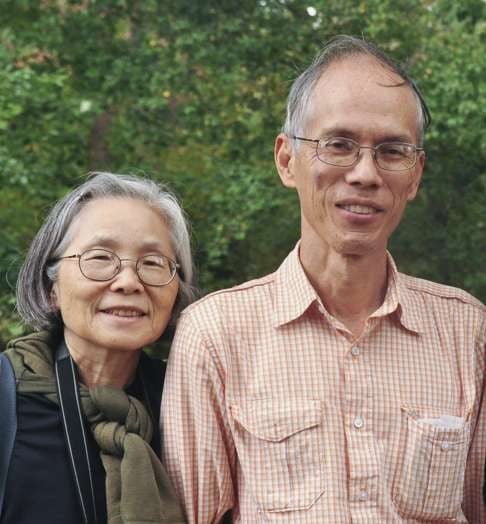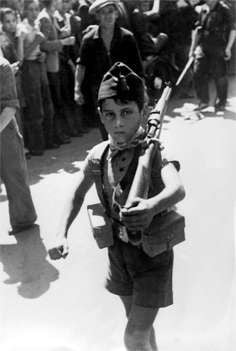Spanish translation at tarcoteca
Illiterate farmers, manual labourers, civil servants – some 100 Chinese joined the International Brigades helping fight General Franco’s fascists 80 years ago. Despite being few in number, they left a lasting impression
In the autumn of 1937, Zhang Ruishu was enjoying a rare break from his 14-hour days on the frontline. One of very few, if not the only, Chinese in Madrid, he hadn’t asked for time off – there was so much to do – but his commander had insisted he take a break. The Spanish capital was decorated with defiant if raggedy banners reading No pasarán (“They shall not pass”) and Madrid será la tumba del fascismo (“Madrid will be the tomb of fascism”). Zhang had seen many such signs before. At a newsstand, however, a large promotional poster for Spanish news magazine Estampa caught his eye.
 Xie Weijin (left) and Zhang Ji (right) with a fellow Chinese in Spain, in 1938. Photo: courtesy of Abraham Lincoln Brigade Archives
Xie Weijin (left) and Zhang Ji (right) with a fellow Chinese in Spain, in 1938. Photo: courtesy of Abraham Lincoln Brigade Archives
The intriguing poster featured a man’s face in profile. It wasn’t a handsome face, but ruddy and weathered, with tightly cropped hair, hollow cheeks and a muddle of crooked teeth in a mouth set slightly agape – the face of a no-nonsense man who had known hardship. Suddenly, a crowd was gathering around Zhang; eyes were widening and fingers pointing. “That’s him!” they cried, lunging forward to shake the stranger’s hand.
Almost 20 years to the day since he had first set foot on European soil, the humble 44-year-old from Shandong province, now a medic with Republican forces fighting fascism in the Spanish civil war, was being hailed as a hero in a country almost 10,000km from home.
 Zhang Ruishu on the cover of Estampa magazine.
Zhang Ruishu on the cover of Estampa magazine.
Just over a year earlier, on July 17, 1936, at the same time as militaristic Japan was becoming increasingly assertive in China, a group of right-wing officers in the Spanish Army, led by General Francisco Franco, rose against the democratically elected Republican government. The move marked the beginning of a civil war that was to last for two years and eight months and provide a prelude to an even greater conflict in Europe.
While Franco’s Nationalists were openly assisted by the German and Italian forces of fascist dictators Adolf Hitler and Benito Mussolini, democratic nations including France and Britain operated an official policy of non-intervention, to the disgust of many of their own people, who saw the struggle as a fight against the evils of fascism and a prelude to even greater conflict in Europe.
In response to their governments’ indifference, tens of thousands of workers, trade unionists and left-wing students mobilised and headed to Spain, to take up arms. The number of overseas combatants who fought in what came to be known as the International Brigades has been estimated at 40,000, with volunteers flooding in from 53 countries, including France (9,000 people), the United States (2,800), Britain (2,500), Poland (3,000) and even Germany (4,000) and Italy (3,000). They came from Costa Rica and Albania, from Greece, Cuba and Argentina, from Finland, Ireland, South Africa and Bulgaria.
And they came from China.
 Hwei-Ru and Len Tsou.
Hwei-Ru and Len Tsou.
A multi-decade investigation by Len and Hwei-Ru Tsou, two American-Taiwanese research scientists (now retired and living in San Jose, California), has shown that more than 100 Chinese fought shoulder-to-shoulder with the Republicans. Some of their stories are detailed in the couple’s book, The Call of Spain: The Chinese Volunteers in the Spanish Civil War (1936-1939), which was first published in traditional Chinese in Taiwan in 2001 (and extended in 2015), and in Spanish and simplified Chinese in 2013, with new material to be added as it comes to light.
The Tsous’ call to arms was a documentary film made in the US.
 Xie Weijin in Spain, as a soldier in the Spanish civil war.
Xie Weijin in Spain, as a soldier in the Spanish civil war.
“I think it would have been around 1986 when we saw The Good Fight,” says Len Tsou, pointing out that the documentary focused on the Abraham Lincoln Brigade, a battalion of American fighters that had travelled to Spain. “We were really surprised that so many volunteers from everywhere in the world had joined up. Our interest in the International Brigades started then, and we learned as much as we could.”
That year was the 50th anniversary of the war’s commencement, and Abraham Lincoln Brigade veterans published a brochure to mark the occasion. It contained a complete roster of the volunteers.
“Len and I looked through and there were three Chinese-looking names in there,” says Hwei-Ru Tsou. “We were so shocked. The Chinese at that time were fighting for their own survival – trying to push away the Japanese aggression.”
A seed had been sown, and the couple dug deeper. With many war veterans growing old, the researchers had to move fast, travelling many times to Spain, China, France, the Netherlands, Bulgaria, Germany and other countries to interview ex-soldiers, former volunteers, relatives and friends, and sifting through reams of official documents.
 Bi Daowen (fourth from right) as a guest in Yanan of Mao Zedong (far right), in the 1940s.
Bi Daowen (fourth from right) as a guest in Yanan of Mao Zedong (far right), in the 1940s.
They discovered that the Chinese had come from all backgrounds, some from civil-servant families, others had been the lowliest of manual labourers and illiterate farmers. As their numbers had been relatively small, there had been no official Chinese brigade in Spain, and they fought in battalions from other nations, usually chosen depending on their language skills.
While Franco’s Nationalists had might on their side, the Republicans were not completely alone: they received material aid and more than 2,000 combat troops from the Soviet Union.
Mao Zedong sent an open letter of support to the Republicans in May 1937.
 A banner from Zhu De, Zhou Enlai and Peng Dehuai supporting the Chinese volunteers fighting in the Spanish civil war.
A banner from Zhu De, Zhou Enlai and Peng Dehuai supporting the Chinese volunteers fighting in the Spanish civil war.
“If not for the fact that we have the Japanese enemy in front of us,” Mao wrote, “we would surely go join your troops.”
What Mao perhaps did not know was that, by then, a number of Chinese were already there.
Zhang’s road to Europe began as early as 1917, when – at the height of the first world war – Britain and France recruited more than 100,000 Chinese to labour in factories whose regular workforces were now fighting at the front. Born into extreme poverty in 1893, Zhang – orphaned since a teenager, jobless, illiterate and desperate – signed up, boarding a ship packed with almost 2,000 other Chinese men bound for Marseilles.
After a gruelling 70 days at sea, Zhang was put to work in a French paper mill. In less than a year, however, Germany had surrendered, the war ended and the Chinese workers were surplus to French requirements. The majority were shipped home.
With no family and no prospects back in China, Zhang decided to stay and try his luck, taking on the unpleasant and dangerous jobs (disinterring corpses and detonating unexploded gas bombs, for instance) that the French avoided.
 Also hailing from Shandong, stout and plucky Liu Jingtian was born in 1890. After a stint in the Chinese army he too journeyed to France in 1917, remained when the war ended and, in 1924, he and Zhang (increasingly an autodidact now teaching himself French) secured steady employment at the Renault car-manufacturing plant in the western Paris suburb of Boulogne-Billancourt. Like many industrial workers at the time, they joined the French Communist Party and, when the Spanish civil war broke out, they were called upon to down tools, cross the Pyrenees on foot and slug it out with fascism.
Also hailing from Shandong, stout and plucky Liu Jingtian was born in 1890. After a stint in the Chinese army he too journeyed to France in 1917, remained when the war ended and, in 1924, he and Zhang (increasingly an autodidact now teaching himself French) secured steady employment at the Renault car-manufacturing plant in the western Paris suburb of Boulogne-Billancourt. Like many industrial workers at the time, they joined the French Communist Party and, when the Spanish civil war broke out, they were called upon to down tools, cross the Pyrenees on foot and slug it out with fascism.
Zhang and Liu arrived in Spain in November 1936, and though they asked to become International Brigade machine-gunners, their ages (both were in their 40s) saw them assigned to medical teams as stretcher-bearers, frequently charged with rescuing wounded soldiers while under fire. As described in Estampa, Zhang was wounded in the chest, shoulders and hands while discharging his duties. A dramatic, heat-of-battle photograph depicting Liu rescuing a wounded soldier was published in Spanish newspaper Frente Rojo, and he was lauded in print for his heroism.
“At the time, it was likely they would not get their [Renault] jobs back; they might not even be able to return to France,” says Hwei-Ru Tsou, “but they went anyway, because it was a very important fight. These two guys were not young, they were both single, and they said to themselves, ‘If the French workers are going, when they have families, they have children, then we are going, too.’ They were extraordinary, and so well loved by their comrades. They were so brave.”
 A Republican fighter in Barcelona, in July 1936. Photo: AFP
A Republican fighter in Barcelona, in July 1936. Photo: AFP
Fighting with the Abraham Lincoln Brigade, Zhang Ji from Minnesota and Chen Wenrao from New York were also originally from China. Chen, born in Guangdong province, was killed at the bloody Battle of Gandesa, in 1938, aged 25. Zhang, however, survived the war in Spain.
Coming from an educated family of relative privilege in Hunan province, Zhang Ji had left China for San Francisco in 1918, receiving a degree in mining engineering from the University of Minnesota in 1923. After the financial crash of 1929, he lost his job as an engineer and became radicalised, joining the Communist Party of the United States in 1935. In March 1937 – aged 37 – Zhang Ji boarded the SS Paris ocean liner in New York and headed for France, then crossed the Pyrenees into Spain. Tall, slim and ungainly, and not the physically strongest of volunteers, Zhang Ji was initially assigned as a truck driver, before taking desk duties.
 Xie Weijin delivers a banner from strikers in Hong Kong to German Communist Party leader Ernst Thalmann in Berlin in 1927
Xie Weijin delivers a banner from strikers in Hong Kong to German Communist Party leader Ernst Thalmann in Berlin in 1927
Described in The Call of Spain as quiet and mysterious, Chinese-Indonesian doctor Bi Daowen (who also went by the Indonesian name Tio Oen Bik) of Java was 31 when he arrived in Spain, in September 1937, while one of the most fervently political of the Chinese was slight, bespectacled Xie Weijin, who was born in Sichuan province in 1899. Xie participated in the anti-imperialist May Fourth Movement in Shanghai in 1919 before heading for France.
In the 1920s, he joined the Communist Youth League in Europe and the Communist Party of China’s European Branch, and a photo taken at a meeting in Berlin in 1927 shows Xie handing over a banner reading “from the strike workers of Hong Kong and Kowloon” to the German communist leader Ernst Thälmann, who would be shot on Hitler’s orders in Buchenwald concentration camp in 1944.
 Spanish Republicans armed against Nationalist rebels in the late 1930s. Photo: AFP
Spanish Republicans armed against Nationalist rebels in the late 1930s. Photo: AFP A young Republican during the Spanish civil war. Photo: AFP
A young Republican during the Spanish civil war. Photo: AFP
Xie headed for Spain in April 1937. In a letter to the Communist Party of Spain, he wrote, “I came to Spain not for a short stay but to go to the battlefront. I will exert my utmost to fight as a soldier. I hope the committee will grant me this right and let me join the International Brigades just like many other foreign comrades.”
Xie was made a machine-gunner with the Austrian battalion but was removed from the frontline after being shot through his right leg, below the knee.
According to the Tsous’ research, Chen Agen was possibly the only Chinese volunteer who came to the war directly from China. Chen was, in fact, fleeing the authorities, having organised a trade union in Shanghai. While heading for Europe in 1937, a Vietnamese cook – rumoured to have been Ho Chi Minh – regaled Chen with tales of the anti-fascist derring-do in Spain, so he travelled there to fight, only to be captured and put to labour as a prisoner of war.
I felt that this great man had been forgotten, not only by his own people, Indonesian people, and his comrades, but also by the world


No hay comentarios:
Publicar un comentario